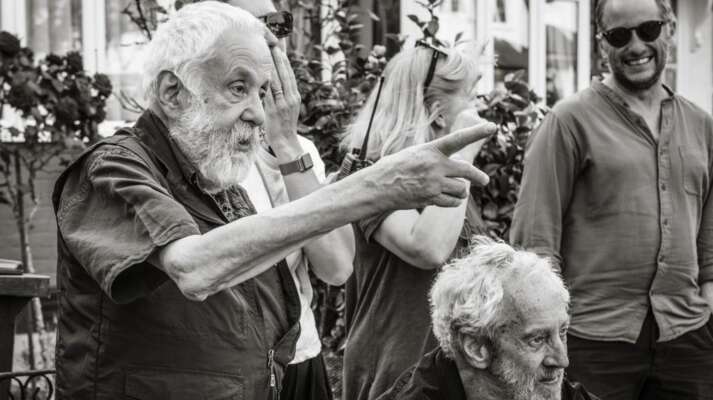Impossible Missions
From The Guns of Navarone to ANTHROPOID
Impossible Missions
Written by Peter Bowen
ANTHROPOID | A Powerful Emotional Journey
Sean Ellis’ ANTHROPOID recreates one of World War II’s great feats of heroism and sacrifice. In 1942, two Czechoslovakian resistance fighters, who’d been parachuted into Prague by the Czechoslovakian government in exile in London, worked undercover for months to put into action a plot to assassinate the Nazi leader Reinhard Heydrich. While the details and outcome of the plot are now written into the pages of history, Ellis’s film––with Jamie Dornan and Cillian Murphy playing the famed patriots Jan Kubiš and Jozef Gabčík––brings to the screen the emotional journey and personal sacrifice of these men. “I wanted to discover what it was like to be Jan Kubiš and Josef Gabčík, to know what it would have felt like to be confronted with the ultimate act of resistance,” Ellis explains. For years, remarkable tales of men and women who risked everything to accomplish impossible missions have inspired some of cinema’s great storytellers. We look at a few of these epic tales in which high-voltage action and patriotic sacrifice join forces.
The Guns of Navarone | A New Type of Blockbuster

J. Lee Thompson’s 1961 The Guns of Navarone set the template for big-budget World War II action movies about men whose patriotism pushed them to take on impossible missions. Ironically, it was the House Un-American Activities Committee (HUAC) questioning the patriotism of writer/producer Carl Foreman that paved the way for the film’s production. After going into self-imposed exile in London in 1952, Foreman, who written the American classic High Noon, was looking to create an international blockbuster. Alistair MacLean’s 1957 bestseller, The Guns of Navarone, seemed liked the perfect project. Filled with intricate details about the real Battle of Leros, MacLean’s novel described a do-or-die adventure about a gang of ragtag heroes from different nations who launch an impossible commando raid in 1943 to take out the German guns on the fictional island of Navarone in the Aegean Sea. In putting the film together, Foreman highlighted the unit’s international make up: an American Captain, Keith Mallory (Gregory Peck), a Greek Colonel, Andrea Stavrou (Anthony Quinn), and the British Corporal Miller (David Niven). Shot on location in Rhodes, the film’s initial two-million dollar budget soared to nearly six million before the film was done. But film’s big-screen action and sweeping Greek vistas made it both a box-office and critical success, earning over $28 million and being nominated for seven Academy Awards (including Best Picture, Best Director, and Best Screenplay). It only won for Best Effects. While many critics derided its popcorn ambition, they nevertheless loved its entertainment value. “The Guns of Navarone,a World War II military exercise of the those-poor-devils-haven't-got-a-chance school, is the most enjoyable consignment of baloney in months,” wrote Time magazine. But the heroic values instilled in the film’s story have continued to resonate with generations. For Salon’s Michael Sragow, “the movie is about weighing ends and means, testing personal and national loyalties, and measuring one's capacity for sacrifice. That's why, when director J. Lee Thompson detonates the action set pieces, they're not just thrilling––they're cathartic." This World War II adventure of rough-and-ready ruffians taking on the Nazis spawned countless imitations, including its own 1978 sequel, Force 10 from Navarone.
The Great Escape | The Indomitable Human Spirit

John Sturges’ 1963 action The Great Escape brought to the screen the real-life mass escape of POWs during World War II chronicled in Paul Brickhill's 1950 non-fiction book of the same name. Brickhill was an Australian Royal Air Force fighter pilot who was sent to the POW camp Stalag Luft III after being shot down in North Africa. Although he was excluded from escaping himself because of his claustrophobia, Brickhill witnessed and supported the 76 men who tunneled their way to freedom on March 24, 1944. After a weeks-long, nationwide manhunt, 73 of the men were recaptured, and 50 of those were executed by direct orders from Hitler. The last three made their way to safety. John Sturges, who cut his teeth directing B-movies, thought the book would be a great action film. Unfortunately few Hollywood studios agreed with him. “What kind of escape is this? Seventy-six set out but only three get away?" MGM’s Louis B. Mayer famously quipped. In explaining his enthusiasm, Sturges states that the story “was the perfect embodiment of why our side won…With no arbitrary rules, they formulated an organization which eventually clobbered the German machine." The international success of The Magnificent Seven, which Sturges both produced and directed, got him his funding, as well as three of his stars––Steve McQueen, Charles Bronson, and James Coburn. While staying true to the story’s general truth, the filmmakers changed many of the specific details. While a few Americans worked on the tunnel, for example, none were part of the escape. Nor were any motorcycles used by the prisoners. In fact, Steve McQueen’s famous bike-jump stunt was proposed by the actor in order to beef up his character. In other ways, the film was too real. Wally Floody, the Royal Canadian Air Force pilot who’d been dubbed the “tunnel king” for his work in coordinating the original escape, was hired as a technical consultant. Soon after visiting the set, he started having nightmares of his time there as a prisoner. A huge box-office hit, The Great Escapewas generally applauded by critics as pure entertainment. “John Sturges has created classic cinema of action,” wrote Time magazine at the time. “There is no sermonizing, no soul probing, no sex. The Great Escape is simply great escapism." Over the years, however, the film’s stature has grown. “This is one of the all-time great war movies…that celebrates the indomitable spirit of the Allied forces even when their backs were to the wall,” Radio Times’ Andrew Collins writes. Despite so few prisoners making it to freedom, the Great Escape was in many ways a strategic success. Paul Brickhill estimates that 5,000,000 Germans were tied up for weeks in the nationwide search for the escapees.
The Dirty Dozen | Making A Modern War Movie

E. M. Nathanson’s best-selling 1965 novel, The Dirty Dozen, which was adapted into Robert Aldrich’s 1967 film of the same name, wasn’t completely a piece of fiction. Russ Meyer, the infamous director of Faster, Pussycat! Kill! Kill!,originally told Nathanson about a team of criminal soldiers, the Filthy Thirteen, so named because of their refusal to bathe before going to battle. Such an army demolition unit actually did exist, but they were nowhere near as felonious as Nathanson pictured in his book. “We weren’t murderers or anything, we just didn’t do everything we were supposed to …We were always in trouble," notes Jack Agnew, a member of the original Thirteen. After acquiring the rights to Nathanson’s book, MGM tapped veteran screenwriter Nunnally Johnson (How to Marry a Millionaire) to adapt it. Wanting something a bit stronger, Aldrich explained that Johnson’s version “would have made a very good, very acceptable 1945 war picture. But I don't think that a 1945 war picture is necessarily a good 1967 war picture." Aldrich asked Lukas Heller, with whom he worked on Hush…Hush, Sweet Charlotte and What Ever Happened to Baby Jane?, to give the tale more of a bite with black humor and over-the-top violence. During the preparation and production, Aldrich took the film’s already gritty premise––a group of violent criminals persuaded to undertake a suicide mission with the promise of a pardon––and pushed each character to become a little more extreme. Lee Marvin plays the Major who oversees the suicide mission to take out a heavily guarded French chateau filled with the top Nazi brass. His dirty dozen includes a mobster psychopath (John Casssavettes), a Bible-thumping rapist (Telly Savalas), a dim-witted murderer (Donald Sutherland), an African-American man convicted for killing a white man in self-defense (football star Jim Brown), and a soldier sentenced for murdering a medic (Charles Bronson), among others. This violent mission in which only a handful survived became a box-office sensation, earning over $45 million worldwide from a production budget of just over $5 million. But many critics were completely perplexed by, if not apoplectic about, its extreme violence. "The Dirty Dozen is so full of socially deleterious propaganda that everyone connected with it should be ashamed,” writes Films in Review’s Gordon Drummond. “Criminal and psychopathic forms of sadism are made to seem no different from those of war." While hardly a pacifist, Aldrich saw the film’s over-the-top violence as an anti-war statement, especially in the Sixties. “The nature of war is dehumanizing,” Aldrich explains. “There's no such thing as a nice war." For Moviefone’s Gary Sussman, The Dirty Dozenendures not just as great entertainment, but in setting the tone for every anti-establishment hero that would follow in its wake: “Every lawman who bitterly grinds his badge into the dust, every crimefighter who must become as monstrous as the brutes he pursues, every warrior who expects our admiration for his willingness to shoot first and ask questions later--all of them owe a debt to The Dirty Dozen and the challenge it offered us, to see something admirable and even noble in antisocial violence channeled in the right direction."
Valkyrie | The Heroic Germans

Bryan Singer’s 2008 historical adventure Valkyrie stars Tom Cruise as Colonel Claus von Stauffenberg, one of the masterminds of a failed 1944 plan to assassinate Adolf Hitler. The film began in 2002, when the screenwriter Christopher McQuarrie, while scouting locations for another film, was shown the memorial to Stauffenberg at the Bendlerblock complex in Berlin. Fascinated by this German national hero he’d never heard of, McQuarrie, working with Nathan Alexander, researched and wrote a screenplay about operation Valkyrie, the real-life failed coup by German officers to kill Hitler. After being seriously injured in Tunisia in 1942, lieutenant colonel Stauffenberg was sent back to Germany, where, disenchanted by Hitler’s policies, he joined forces with other high-ranking officers in a conspiracy to remove the Führer by any means necessary. After several aborted attempts, Stauffenberg made his move on July 20, 1944, when he was with Hitler in his Wolf’s Lair bunker in East Prussia, a region that is now part of Poland. After placing a briefcase with plastic explosives under a conference table near Hitler, Stauffenberg excused himself, rushing to catch a plane to Berlin where he and the other members of the conspiracy would attempt to wrest control of the army as the nation dealt with the Führer’s demise. Unfortunately, the bomb, which killed four people in the room, did not hurt Hitler. Within a day, the top conspirators were rounded up and executed in front of the military headquarters at Bendlerblock, the same place where McQuarrie saw the monument to Stauffenberg. In the next few months, Hitler demanded the Gestapo round up anyone remotely connected to the conspiracy, a witch hunt that resulted in more than 7,000 people being arrested, and 4,980 executed. McQuarrie originally saw the film as a small, but complex drama of bravery among characters normally consider the enemy. At the heart of Valkyrie, McQuarrie told Cinema Blend, is “a movie about what these men tried to do, what they risked and the sacrifice they ultimately made, the elements that make up the best sort of cinema, and specifically what appeals to an American audience more than anything else, which is these are guys who took on the system.” When McQuarrie’s friend Bryan Singer signed on to direct, the scope of the film shifted from independent to epic. Singer signed on Tom Cruise not only to produce, but also to star, especially since there is an uncanny resemblance between Stauffenberg and the actor. If the filmmakers had anxiety about getting an American audience to connect to a war story with German heroes, they soon found that the German government was equally nervous about Americans telling this tale. From Cruise’s connection to Scientology to the film’s request to shoot at actual historical locations, like Bendlerblock, the German government proved initially very hesitant to get behind this Hollywood treatment of one of their few World War II heroes. But even after the Germans got on board, the filmmakers still had to sell their historical tale to American audiences. In marketing the film, United Artists turned away from selling it solely as a Tom Cruise movie and opted instead to showcase the impossible mission aspect of the film. With posters reminiscent of The Great Escape and The Dirty Dozen, Valkyrie felt like a classic ’60s action thriller.
Inglourious Basterds | History Rewritten By Hollywood

For his 2009 war saga, Inglourious Basterds, Quentin Tarantino originally was drawn to the rough-and-ready commando films of the 60s and 70s. “I was thinking of the men-on-a-mission movies, Where Eagles Dare, The Dirty Dozen…” Tarantino tells List Film. Even the film’s title’s is borrowed from a translation of a 1978 Italian action picture loosely based on The Dirty Dozen. But as Tarantino started exploring his characters and ideas more fully, he became enamored of an earlier genre of films dealing with resistance fighters. Citing such heroic movies as Jean Renoir’s This Land is Mine, Fritz Lang’s Manhunt, and Jules Dassin’s Nazi Agent, Tarantino explains “these were movies made at exactly the time of World War II, when the Nazis weren’t just bogeymen from the past, but were actually a threat. Many of the directors had personal experience with the Nazis. Yet these movies are entertaining, thrilling, exciting, humorous even… These were the movies I got inspiration from, not stylistically, but in terms of their entertaining spirit.” In many ways, these two genres inform the two storylines that come together for the film’s climatic ending. The Dirty Dozen aspect is captured by the Basterds, a troop of take-no prisoners Jewish-American soldiers lead by Lieutenant Aldo "The Apache" Raine (Brad Pitt). The other strain, with its own witty and cultured villain, SS colonel Hans Landa (Christoph Waltz), follows Shosanna Dreyfus (Mélanie Laurent) on her quest to extract vengeance for her family’s extermination by Landa. The two film genres violently collide in a Parisian cinema run by Dreyfus. All of the Nazi elite, including Adolf Hitler, are there for the premiere of Stolz der Nation, a jingoistic army film spotlighting the famed Nazi sniper, Fredrick Zoller (Daniel Brühl). What happens next, an audacious act of revenge more reminiscent of Ernst Lubitsch’s 1942 To Be or Not to Be than any actual event, demonstrates clearly that Tarantino has no interest in repeating history, either by sticking to genre rules or chronicling the war. In a form of cinema activism, Tarantino allows audiences to imagine how they wish the war had gone, rather than seeing what actually happened. As USA Today’s Claudia Puig points out, “he exercises both his obsession with vengeance and his fascination with the movies. The outcome is gory and glorious.” The film was nominated for eight Academy Awards, with Christoph Waltz winning for Best Performance by an Actor in a Supporting Role.


